What’s the first thing that comes to mind when you think of Barcelona?
If you said tapas and Spanish food, then you’re our kind of people, but I imagine most would say Sagrada Familia – the iconic church designed by the celebrated Spanish architect Antoni Gaudí. It’s a breathtaking sight and marvel of modern architecture that few buildings in the world can match.
Sagrada Familia is a must for every first-time traveler to Barcelona. Being the city’s most popular tourist attraction, there’s no shortage of guided tours that can take you there. But if you’re interested in visiting the church and other famous Gaudí buildings in Barcelona, then one pass you may want to consider is the Go City Barcelona Pass.
In this article, we’ll tell you exactly what the Go City Pass is, what it can do for you, and how you can use it to go on your very own Gaudi Barcelona whirlwind tour.
¡Vamonos!
GAUDI IN BARCELONA QUICK LINKS
To help with your Barcelona trip planning, we’ve put together links to recommended hotels, tours, and other travel-related services here.
HOTELS
Recommended hotels and apartments in and around Placa Catalunya, one of the best areas to stay for people on their first trip to Barcelona.
- Luxury: Ohla Barcelona
- Midrange: Hotel Monegal
- Budget: Urbany Hostel BCN GO!
TOURS
- Sightseeing Tour: Sagrada Familia Tour
- Food Tour: Tapas Walking Tour with Food, Wine, and History
- Day Trip: Montserrat Half-Day Wine and Tapas Trip
- Cooking Classes: Cooking Classes in Barcelona
OTHER SERVICES
Save This on Pinterest!
No time to read this guide on the top Gaudi attractions in Barcelona? Click on the save button and pin it for later!

GUIDE TABLE OF CONTENTS
WHO IS ANTONÍ GAUDI?
So much has been written about Antoni Gaudi so I’ll keep this short.
Antoni Gaudí i Cornet (1852-1926) was a Spanish architect and designer renowned for his unique art nouveau style. Considered the greatest practitioner of Catalan modernism, he was known for his distinctive style that combined elements of nature and religion – two of Gaudi’s greatest passions in life.
Understanding his obsession with nature and religion gives you a better appreciation for Gaudí’s work. Elements of both take prominence in almost everything he did – from his earliest works like Casa Vicens to his crowning achievement Sagrada Familia.
Antoni Gaudi has a handful of notable works outside of Catalonia – like El Capricho de Gaudi in Comillas – but most of his work is located in Barcelona. Sagrada Familia is his most visited monument but seven of his works in Barcelona have been declared UNESCO World Heritage Sites (Works of Antoni Gaudi), five of which we visited in two days using the Go City Barcelona Pass.
WHAT IS THE GO CITY PASS?
The Go City Pass is a tourist pass that gives you access to a multitude of tours and attractions in different cities around the world like Barcelona, Madrid, Bangkok, Singapore, and Seoul. We used our passes to visit five Gaudi attractions in Barcelona but it gives you access to many other tours and attractions as well – like tapas tasting tours, walking tours, and entrance to various museums around Barcelona.
The Go City Pass comes in two variations – the All-Inclusive Pass and the Explorer Pass. If you plan your trip well, then both can save you a good amount on the total cost of admission. I’ll explain the differences between the two below but you can check the Go City website for available tours and attractions in Barcelona, pricing information, and to purchase your passes.
All-Inclusive Pass
The Go City All-Inclusive Pass gives you access to as many tours and attractions as you like for the duration of your pass. It’s available in 2-5 day passes.
Explorer Pass
The Go City Explorer Pass allows you to visit a set number of attractions. It’s available in 2-7 choice passes and is valid for 60 days from the date you first use your pass.
WHY SHOULD I GET THE GO CITY PASS?
This is easy – money and convenience.
Either version of the Go City Barcelona Pass will save you on the total cost of admission and the hassle of having to buy each ticket separately. The Go City website lists the normal ticket price for all available tours and attractions so you can easily see how much you’ll be saving with either pass. In our case, we saved EUR 55 each with our 5-choice Go City Explorer Passes.
To make sure you don’t wind up spending more, Go City offers its customers a risk-free savings guarantee. If it turns out that the individual entry tickets to the attractions you choose cost less than the Go City pass you purchased, then they’ll refund the difference (terms and conditions apply).
Be sure to check out Go City’s risk-free savings guarantee for more information.
WHICH GO CITY PASS SHOULD I GET?
This depends on you. If you’re interested in a lot of the Barcelona tours and attractions offered on the Go City website, then the All-Inclusive Pass will be a better value. But if you’re like us and only want to visit a few attractions each day, then the Explorer Pass is the preferred option.
Most attractions are accessible using either pass but for some reason, some are available on just one or the other. You can check the Go City website for a list of available tours and attractions.
TOP ANTONI GAUDI ATTRACTIONS IN BARCELONA
As advised, you can use either pass to do any of the tours and attractions listed on the Go City website, but we used our 5-choice Explorer Passes to visit the most famous buildings in Barcelona designed by architect Antoni Gaudí.
If you’re a fan of Gaudí’s work, then you may want to do the same.
1. La Sagrada Familia
When you hear the name Antoni Gaudi, the first words that come to mind are “La Sagrada Familia”. This breathtaking church and monument is the crowning achievement of Gaudi’s career.
Sagrada Familia is spectacular as it is but as you can see from the picture below, it’s still unfinished. If I remember our tour guide correctly, the church is scheduled to be finished in 2026, exactly a hundred years after the architect’s death. Gaudi died in 1926 after he was struck by a passing tram.
This was our second time visiting the church but the first with a tour guide. It’s easy enough to visit any monument on your own but the experience is more fulfilling with a guide because you learn so much more. There were about 20 people in our group and we were all given earpieces so hearing his explanations was never a problem.
Just looking at the church’s facade, you can see the natural world’s influence on Gaudí’s style. Can you guess what those whitish columns were inspired by?

Like most of Gaudí’s work, nearly every square inch of the building’s facade is rife with details. Our tour guide spent a good amount of time explaining many of the church’s most fascinating details to us, interesting bits of information that we never would have learned on our own – like the stories behind these sculptures for example.
Because this is a small group guided tour, advanced bookings are required. I’ll tell you more in the TRAVEL TIPS section of this guide.
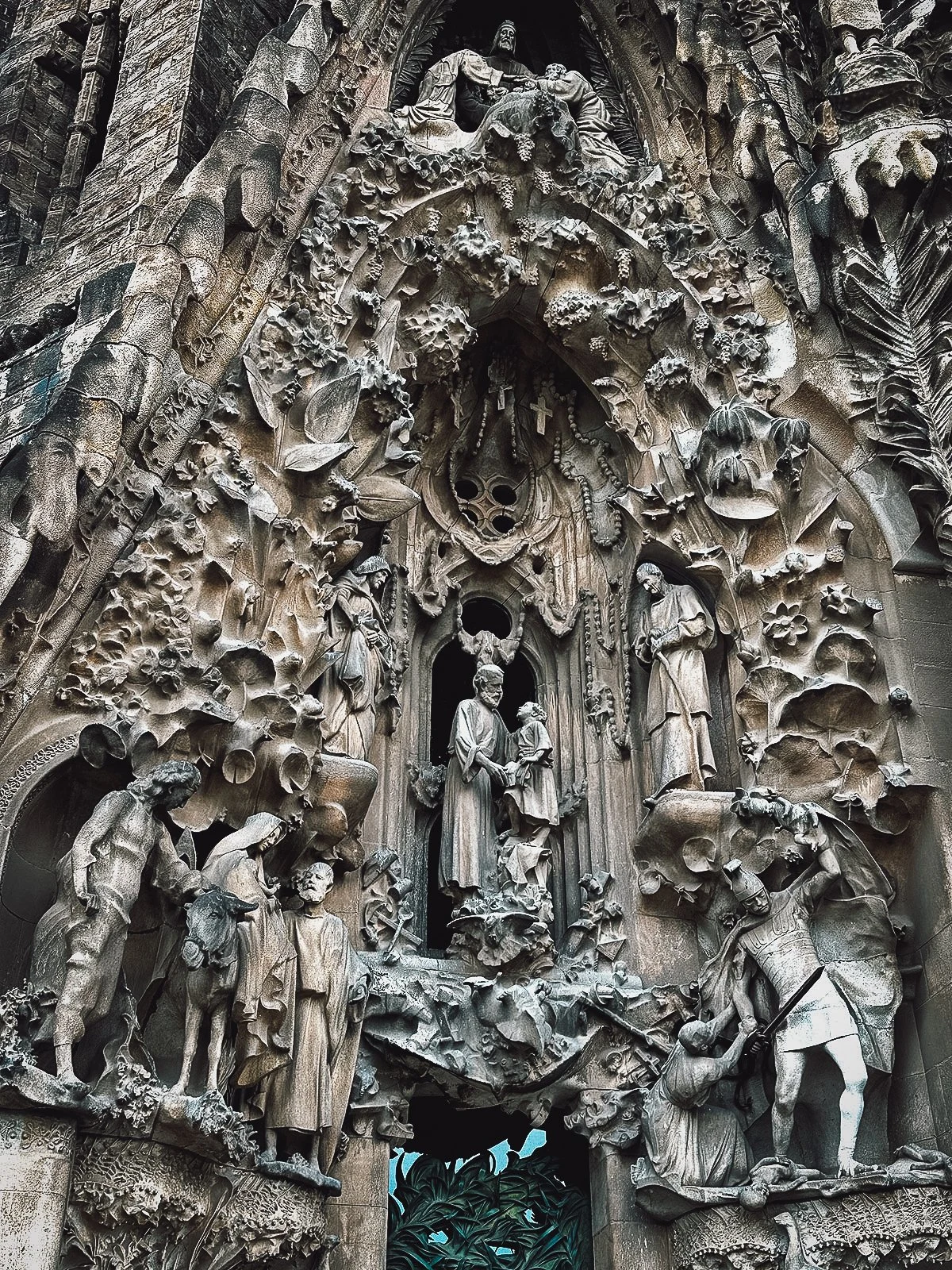
The interior of the church is every bit as fascinating as its facade. Note the columns – they’re meant to mimic trees.
It wasn’t part of our tour but Gaudi’s remains are buried in the Virgen de la Carmen, one of four chapels within the Sagrada Familia crypt. A fitting resting place considering the Spanish architect devoted the last 43 years of his life working on this church.
On his gravestone bears this inscription:
Antonius Gaudí Cornet. Reusensis. Annos natus LXXIV, vitae exemplaris vir, eximiusque artifex, mirabilis operis hujus, templi auctor, pie obiit Barcinone die X Junii MCMXXVI, hinc cineres tanti hominis, resurrectionem mortuorum expectant. R.I.P.
Translated from Latin: “Antoni Gaudí Cornet. Originally from Reus. Born 74 years ago, an exemplary man, an exalted craftsman, and author of the admirable work of this temple, died in Barcelona on 10 June 1926, here the ashes of such a great man await the resurrection of the dead. R.I.P.”

Despite not being a finished work, La Sagrada Familia is a functioning church that holds mass every Sunday. According to our tour guide, its 1,000+ member choir is out of this world. As you can imagine, mass is very popular here so you’ll need to get up at the crack of dawn for a chance to enter the church during the ceremony.
Of all the Gaudí buildings in Barcelona, this is by far the most spectacular. In my experience, only the Taj Mahal measures up to this incredible building.
Our tour didn’t include admission into the church’s towers but you can purchase a separate ticket after the tour.
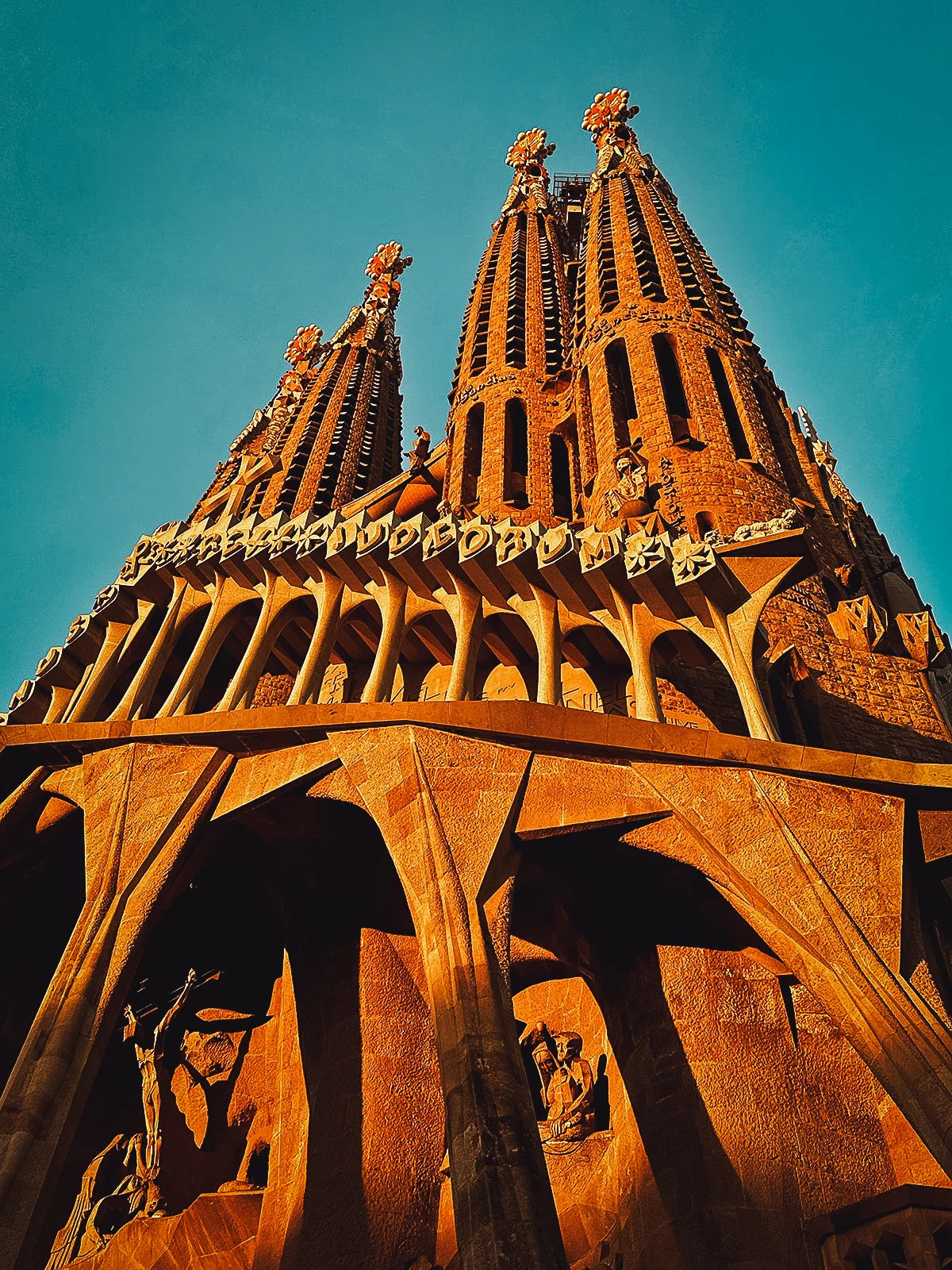
La Sagrada Familia
Address: C/ de Mallorca, 401, L’Eixample, 08013 Barcelona, Spain
Operating Hours: 9AM-6PM, Mon-Sat / 10:30AM-6PM, Sun
2. Park Güell
When we first visited Park Güell in 2019, I couldn’t understand why it was so popular. It was easy to see why the Sagrada Familia got so much attention but not so much this park located in the Gracia district of Barcelona. Difficult to understand that is, until we went on a guided tour and learned about its fascinating history.
Built from 1900-1914, Park Güell was developed by entrepreneur Eusebi Güell as an affluent housing community for Barcelona’s wealthy. However, the project turned out to be a monumental failure, with just two of the envisioned sixty houses being built. One was for architect Antoni Gaudi, and the other for one of Güell’s friends – the only person to buy a plot in the Park.
According to our tour guide, the project failed for a couple of reasons: (1) The area at the time was undeveloped so transportation was difficult; and (2), the area wasn’t far enough from central Barcelona to make it attractive as a second home.

Today, Park Güell is owned by the Barcelona City Council and is arguably the second most famous of the Gaudí buildings in Barcelona. One of its best-known features is this long serpentine bench covered in colorful ceramic tiles.
I never knew this but our guide explained to us that the lower portion of the backrest, the part with the protruding bump, was designed by Gaudi to provide lumbar support. I sat to test it out and it really does work!
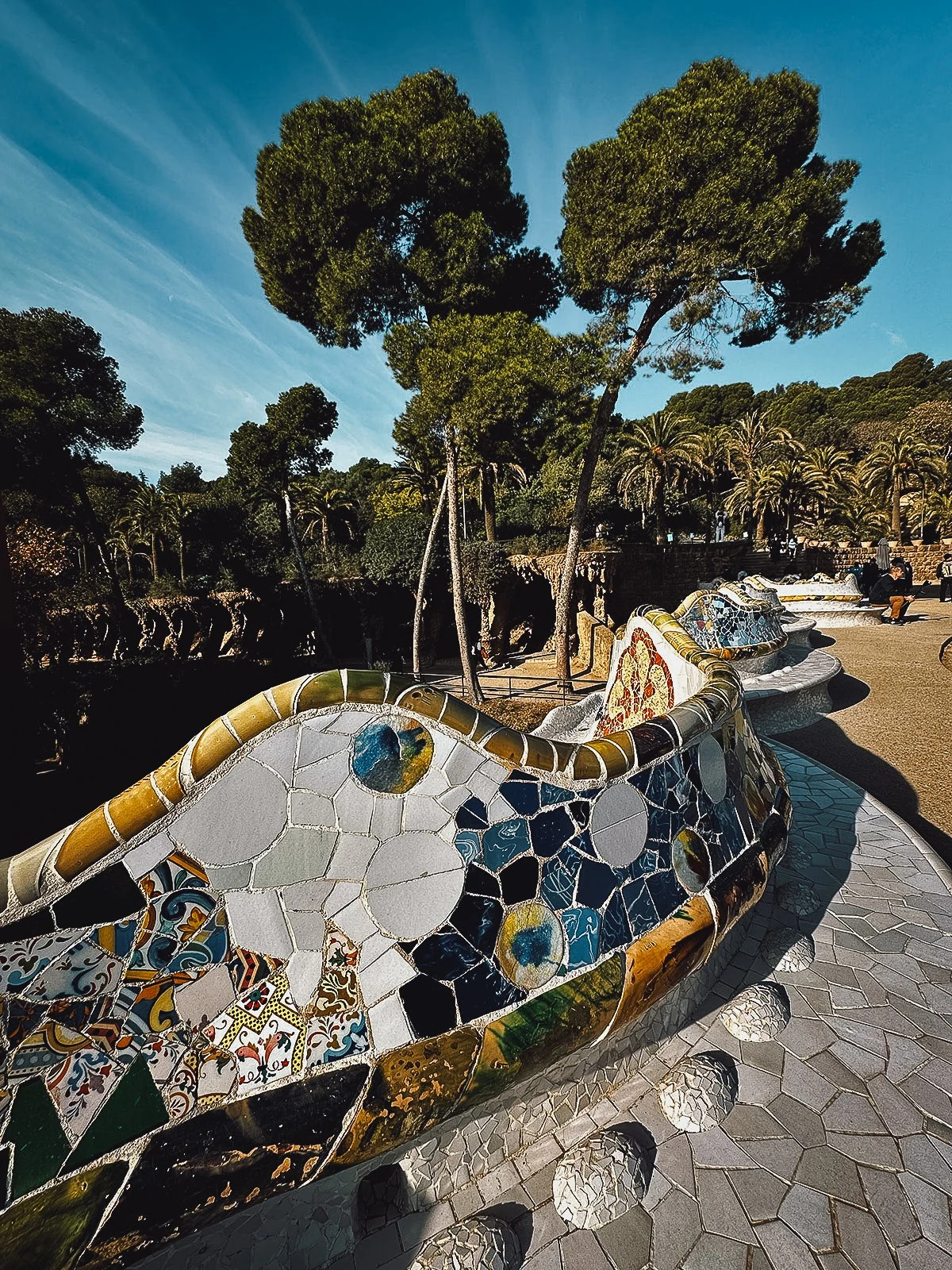
This is the area directly beneath Nature Square plaza. According to our guide, it was meant to be the market area where fresh produce would be sold to the homeowners on weekends.

The tiled bench is my favorite feature at Park Güell but this colorful salamander known as “El Drac” is one of the most photographed sculptures in Barcelona. Our guide didn’t say why it’s so famous but she did explain that it’s part of the irrigation system designed by Gaudi to capture and store rainwater in the park’s underground reservoir.
Like our visit to La Sagrada Familia, this small group guided tour of Park Güell requires advanced reservations. Check out the TRAVEL TIPS section of this guide for more information.
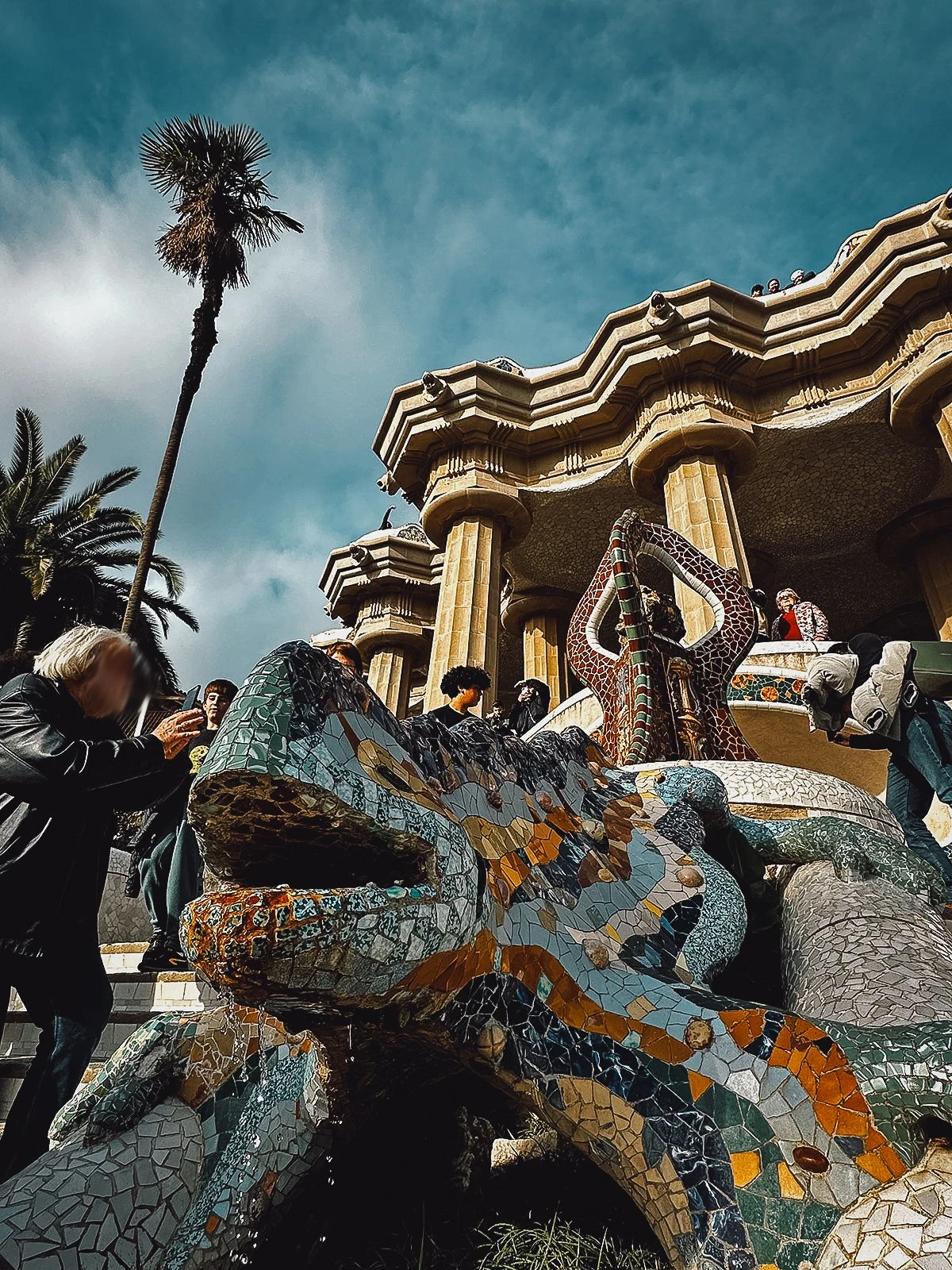
Park Güell
Address: Gràcia, 08024 Barcelona, Spain
Operating Hours: 9:30AM-6:30PM, daily
3. Casa Batlló
Located along fashionable Passeig de Gracia, Casa Batlló was our second favorite Gaudí building in Barcelona. Gaudi designed it for textile industrialist Josep Batlló who gave the architect free rein to redesign the house in any way he wanted.
Unlike the first two buildings on this list, our visits to Casa Batlló, Casa Milà, and Casa Vicens were self-guided tours. You’ll be given a headset that will explain to you each room and the history of the house as you walk through it.
Because this is a self-guided tour, advanced reservations aren’t required.
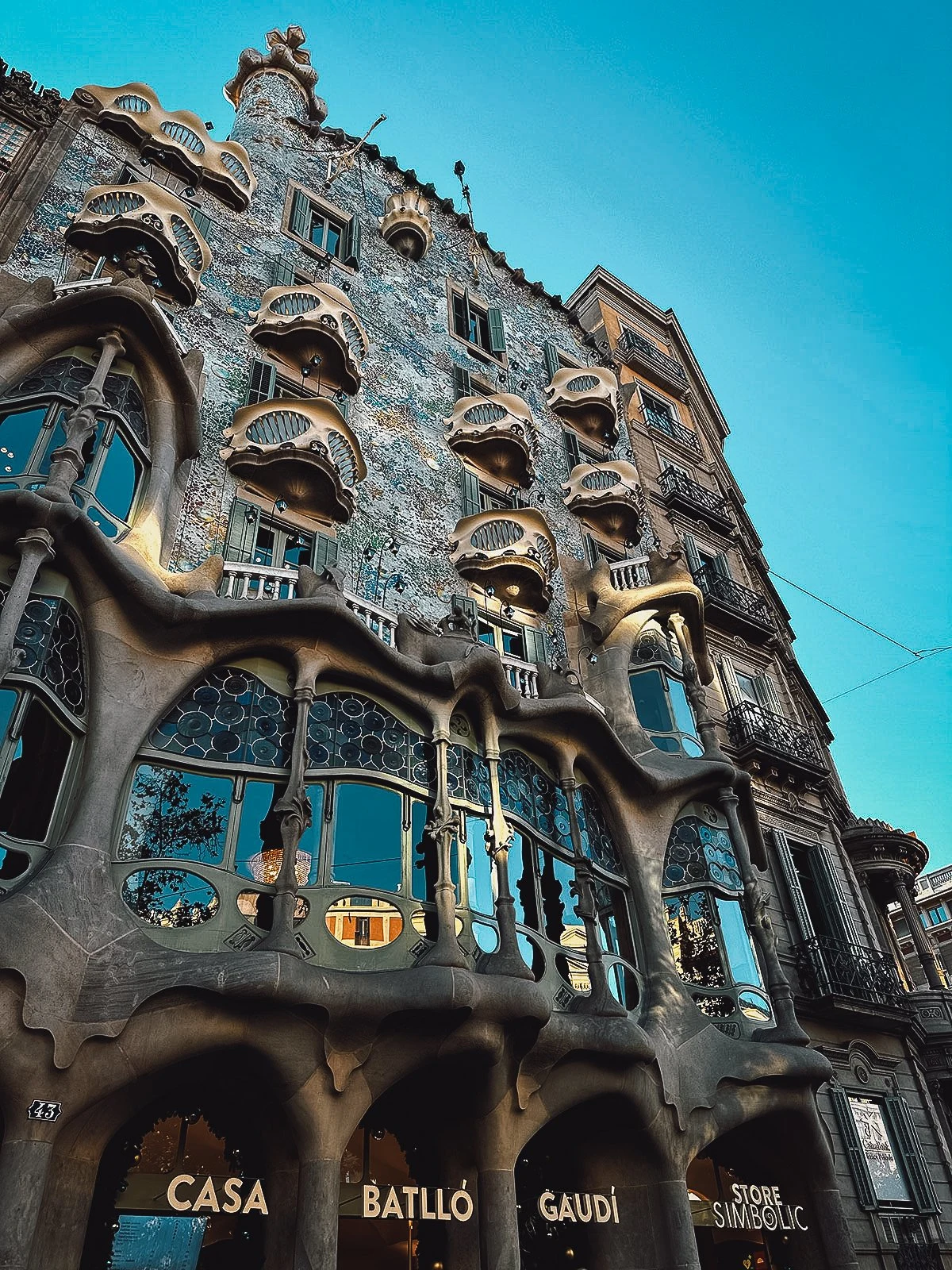
According to the audio guide, Gaudi was inspired by the ocean when he designed Casa Batlló, and it shows. From its colors, shapes, textures, and details, everything about this house will remind you of the sea.
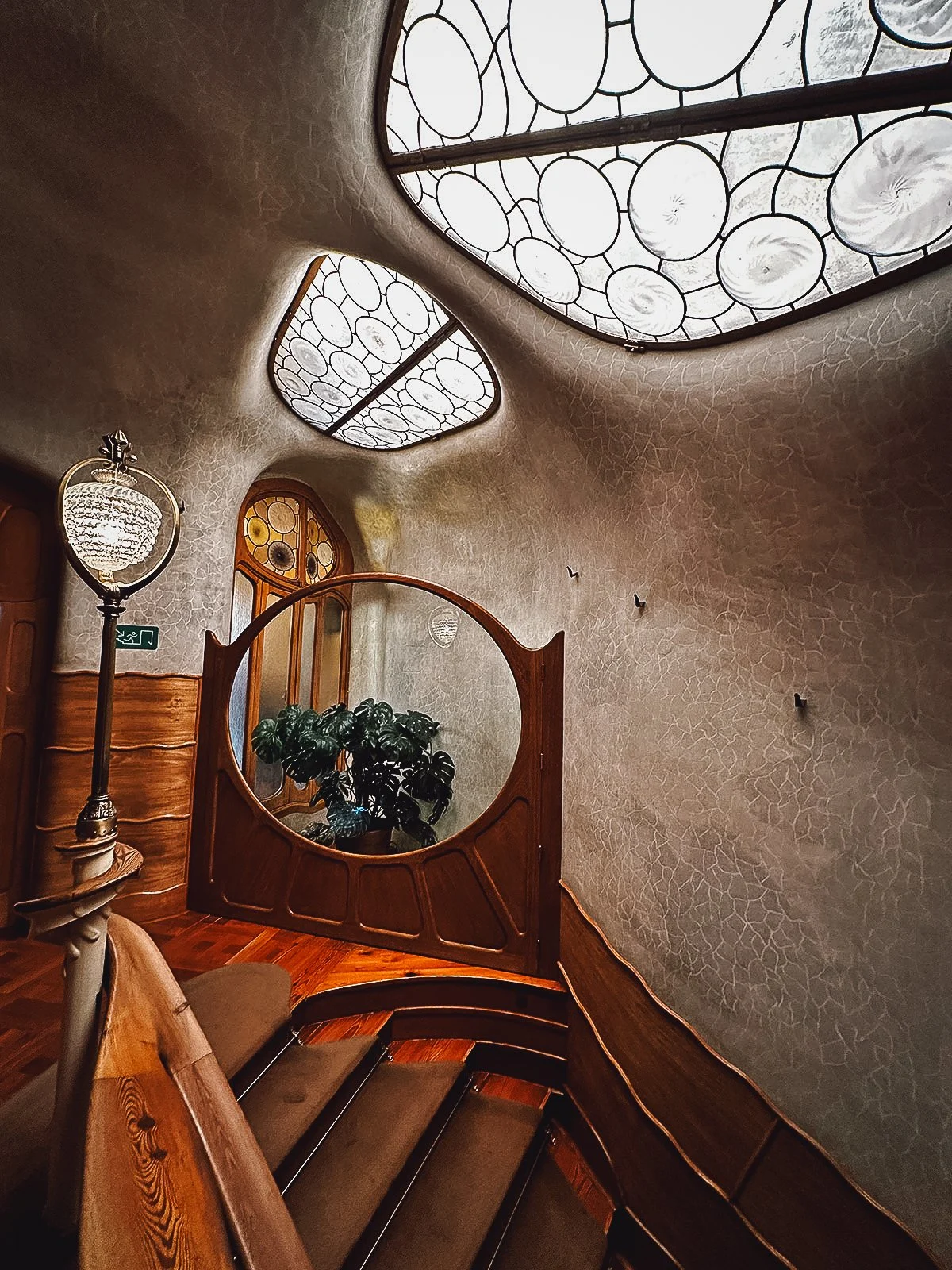
I don’t know what the architectural term is but this central space as you make your way up the house was my favorite part of the building. What does it remind you of?
Gaudí was tasked to design an audacious and creative house that was unlike any other. It looks like he succeeded.

These unusual chimney stacks on the rooftop are another recognizable feature of Casa Batlló. You can see a portion of it on the left side of this picture but the house’s roof terrace was designed to resemble a dragon’s back.
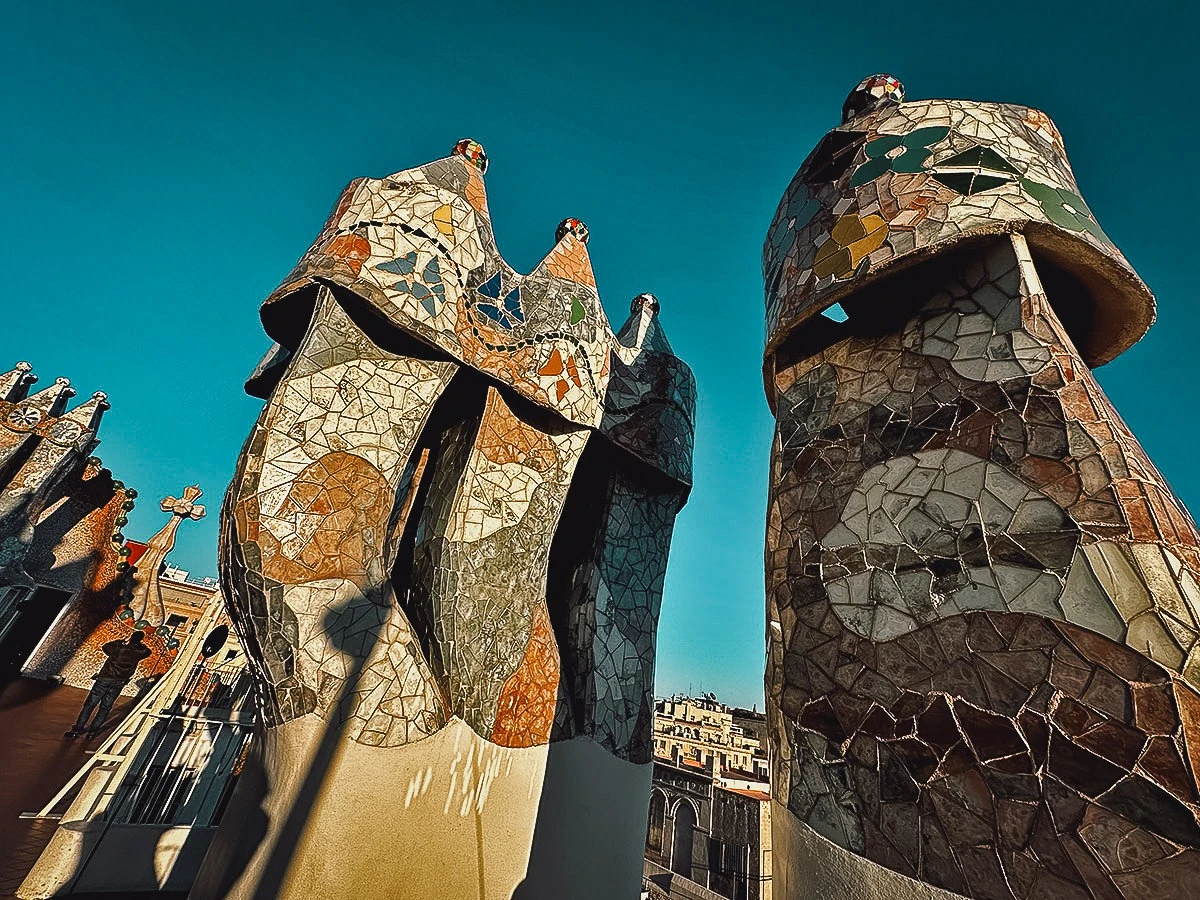
Casa Batlló
Address: Passeig de Gracia, 43, L’Eixample, 08007 Barcelona, Spain
Operating Hours: 9AM-10PM, daily
4. Casa Milà (La Pedrera)
Located along Passeig de Gracia, just a few blocks away from Casa Batlló, is Casa Milà – another of the seven Gaudí buildings in Barcelona listed as UNESCO World Heritage Sites. Nicknamed “La Pedrera” for its uneven quarry-like appearance, this apartment building was the last private residence Gaudi designed before dedicating himself to the Sagrada Familia.
Like Casa Batlló, this Casa Milà tour is a self-guided audio tour that doesn’t require advanced reservations.

Unlike Casa Batlló, the rooms inside La Pedrera look ordinary. The owners of the building lived on the ground floor while renting out the rest of the apartments.

La Pedrera gets more interesting as you make your way up. Pictured here is the building’s attic where the laundry rooms were located.
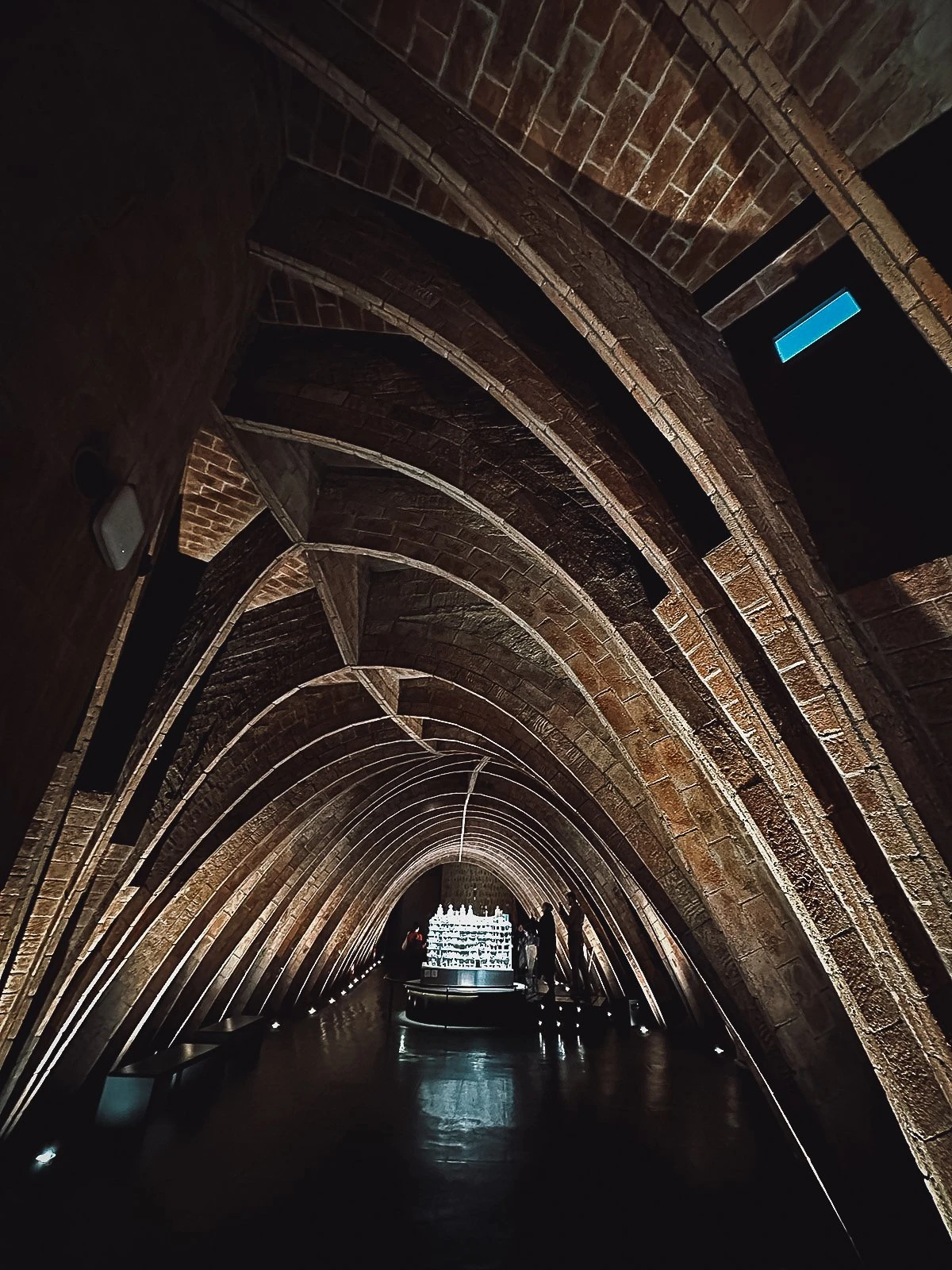
The building’s roof with Gaudi’s signature chimney stacks was the best part about La Pedrera. This space was fun and a great place for pictures.

Casa Mila
Address: Passeig de Gracia, 92, L’Eixample, 08008 Barcelona, Spain
Operating Hours: 9AM-6:30PM, 7-11PM, daily
5. Casa Vicens
Admittedly, this isn’t my favorite Gaudi building but it was interesting to see an example of the architect’s earlier works in Barcelona. Completed in 1888, this was Gaudi’s very first residential project. It looks very similar in style to El Capricho de Gaudi which he designed later that year.
Located along Carrer de les Carolines, it’s clear from the building’s facade that Casa Vicens was designed during a different part of the architect’s career. It’s much more linear and looks quite different from Casa Batlló and Casa Mila.
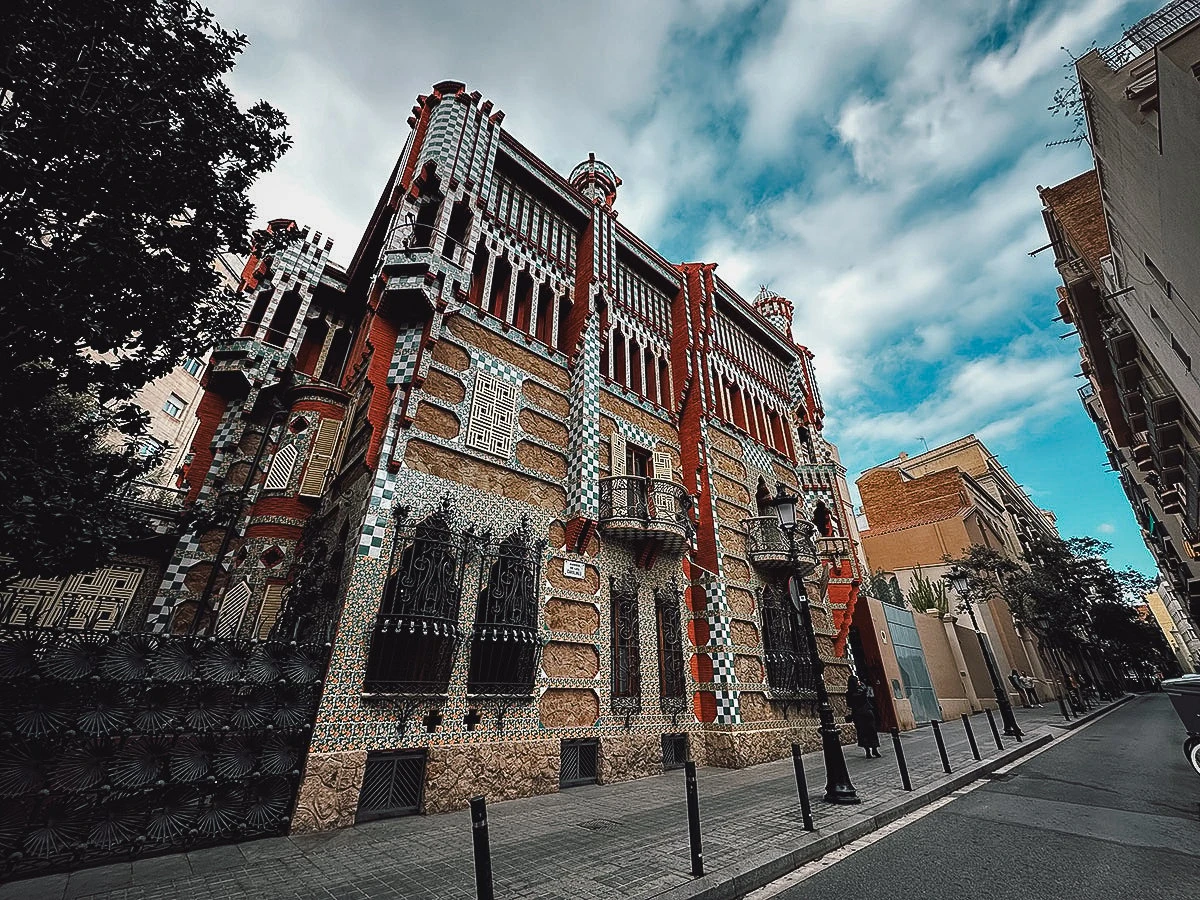
This house may look different from the previous two but the young Gaudí’s style is already apparent here. A UNESCO World Heritage Site, Casa Vicens is considered to be Gaudi’s first major project.

Like Casa Batlló and Casa Milà, the tour at Casa Vicens is a self-guided audio tour that doesn’t require advanced reservations.
This was my favorite room in the house.
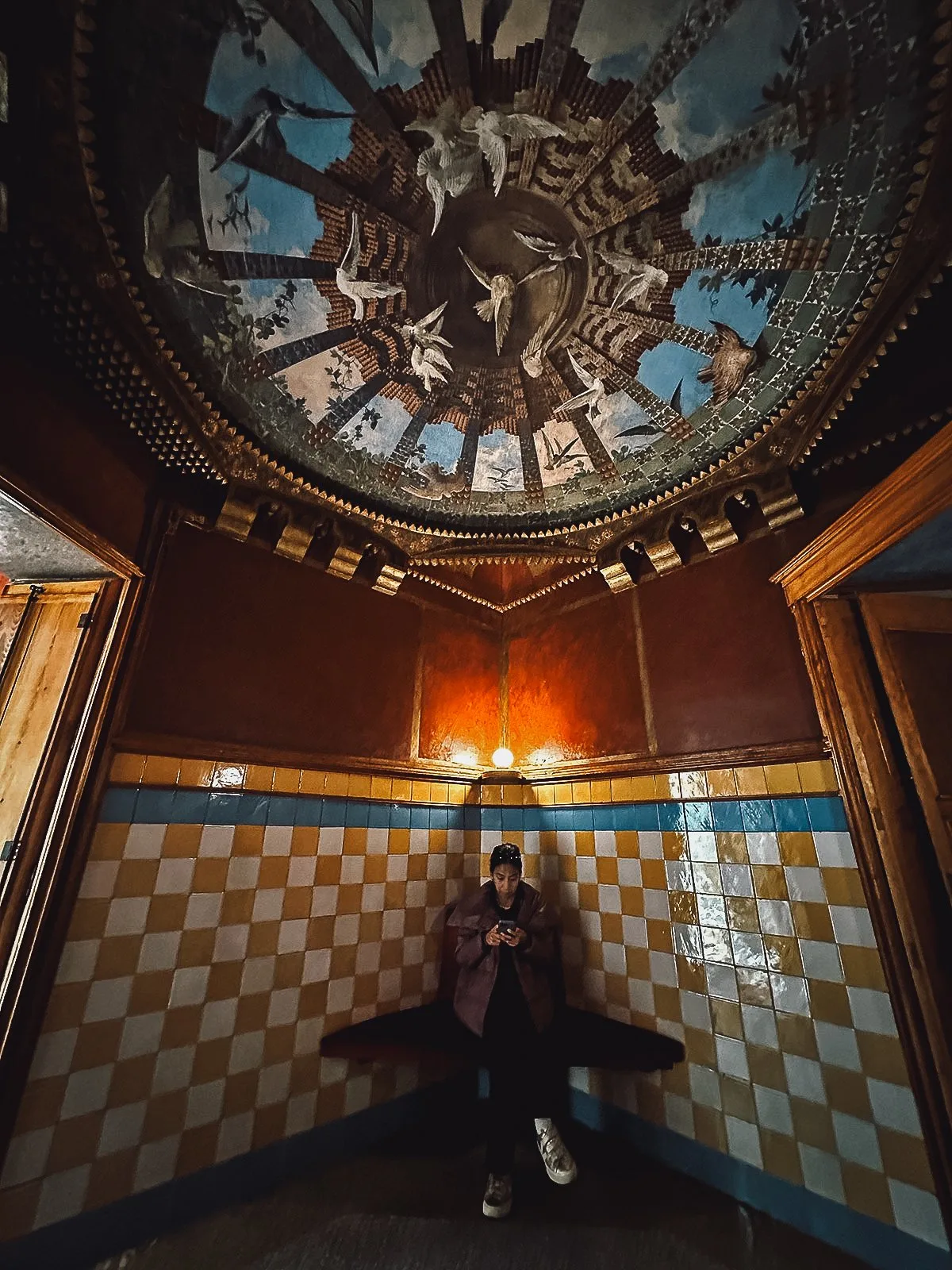
Though colorful, the chimneys here don’t quite reflect Gaudi’s signature architectural style just yet.
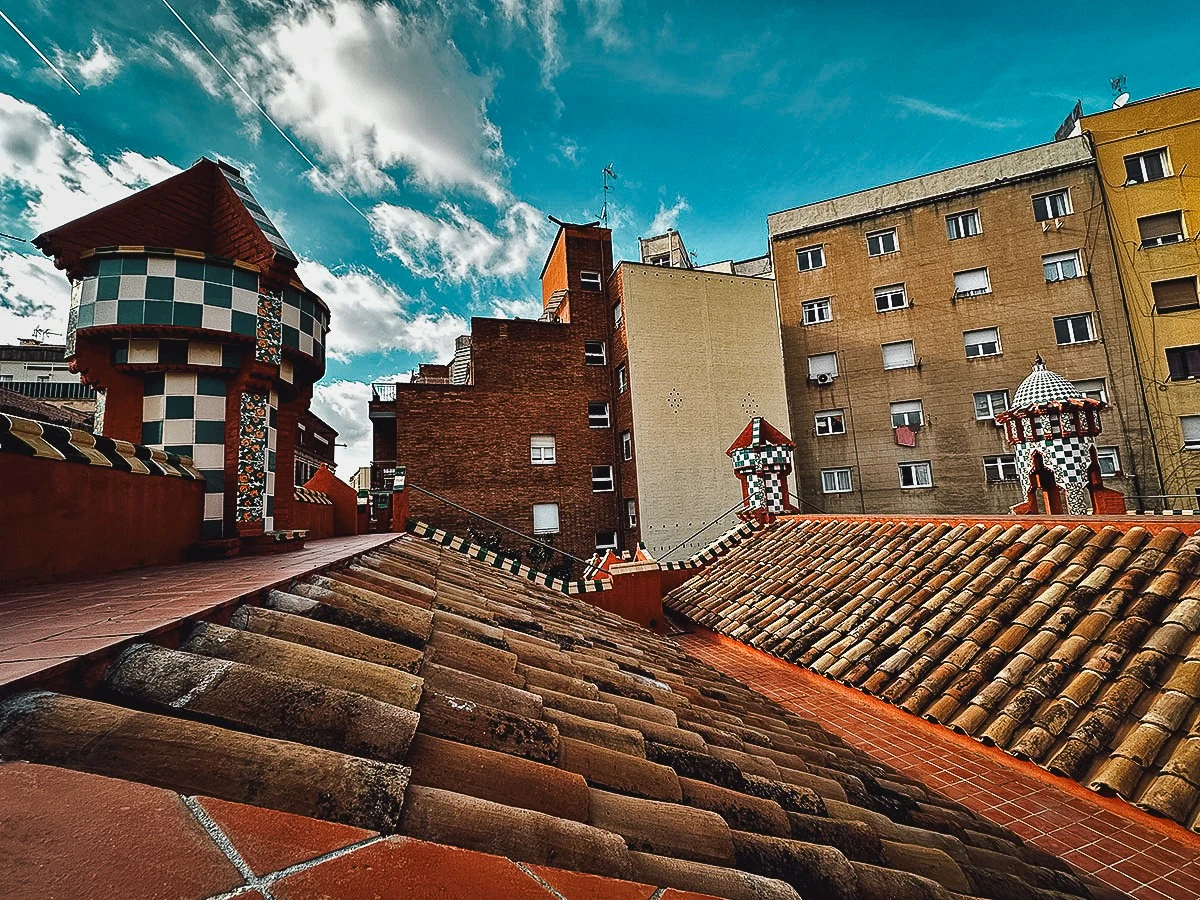
Casa Mila
Address: Carrer de les Carolines, 20-26, Gràcia, 08012 Barcelona, Spain
Operating Hours: 9:30AM-6PM, Wed-Mon (closed Tuesdays)
OTHER GAUDI ATTRACTIONS IN BARCELONA
We used our 5-choice Go City Explorer Passes on the five buildings listed above but people who want to see more of Gaudi’s work can visit these other attractions as well.
Of the five additional attractions listed below, only Colonia Güell is included in the Go City Pass (as of February 2024).
6. Palau Güell
Palau Guell is a mansion in the El Raval neighborhood designed by Antoni Gaudí for his greatest patron, Eusebi Güell. It’s one of the seven Gaudí buildings in Barcelona listed as UNESCO World Heritage Sites.
7. Cripta de la Colonia Güell
Located on a hillside just outside Barcelona, Cripta de la Colonia Guell is a church commissioned by Eusebi Guell. It’s one of the seven Gaudí buildings designated as UNESCO World Heritage Sites.
As described, entry to the Church of Colonia Guell is included in the Go City Pass. This is a self-guided audio tour so advanced reservations aren’t required.
8. Casa Calvet
Casa Calvet is a residence designed by Antoni Gaudi for a textile manufacturer who used the ground floor and basement as a commercial space. Because of zoning limitations, it’s considered by many to be one of his most conventional designs.
9. Finca Güell
Finca Guell refers to a building complex in the Pedralbes neighborhood of Barcelona. It was the first project Gaudi did for Eusebi Guell, who commissioned the architect to design the boundary wall and gates giving access to the property.
The complex is best known for its wrought-iron gate designed in the shape of a dragon.
10. Torre Bellesguard
Also known as Casa Figueres, Torre Bellesguard is a mansion located in the Sarrià-Sant Gervasi district of Barcelona. Bellesguard, in Catalan, can mean either “beautiful view” or “good shelter”.
GAUDI BARCELONA ITINERARY
To help you plan your DIY Gaudi Barcelona tour, this is how we used our 5-choice Go City Explorer Passes to visit the first five attractions on this list.
Day 1
- Park Güell: As advised, this is a small group guided tour so you’ll need to make a booking in advance. There are tours available throughout the day but we chose the earliest time slot at 10:30AM. The tour lasts about 1 hr 30 mins.
- Casa Vicens: Casa Vicens is located just 1.5 km from Park Güell so we walked here after our tour ended. If you’d prefer not to walk, then you can go by public bus.
- La Sagrada Familia: This is another guided tour that requires advanced bookings. There are several time slots available but we joined the 3:30PM tour. The tour lasts about 2 hours.
Day 2
- Casa Batlló: This is a self-guided audio tour so you can come anytime you like.
- Casa Mila: La Pedrera is located just three blocks from Casa Batlló.
HOW TO GET AROUND IN BARCELONA
As you can see from the map below, the Gaudí buildings in Barcelona are spread out. Thankfully, the city’s excellent transportation system makes it easy to get around. Just use Google Maps to know which metro lines or buses to take between destinations.
We used T-Casual cards to get around which you can purchase from a ticketing machine at any metro station. It allows you 10 journeys using the metro or bus for 75 minutes of travel time per journey. The card is non-transferable so each person needs to get their own T-Casual card.
Alternatively, you can check Get Your Guide for a list of transport cards you can use in Barcelona.

GO CITY BARCELONA TRAVEL TIPS
1. Make Reservations Early
As previously advised, a few of the Go City tours and experiences require advanced reservations. You can do this from the Go City website after purchasing your pass.
La Sagrada Familia and Park Guell are two of the most visited monuments in Barcelona so making reservations well in advance is recommended. If you can, then I suggest booking a few weeks before your trip.
2. Claim Your Entry Tickets First
For the Gaudí buildings with self-guided tours like Casa Batlló, Casa Mila, and Casa Vicens, you’ll need to claim your entry tickets first before being allowed entry.
From your mobile phone, present your Go City Barcelona Pass at the front desk so they can issue you an entry ticket. Only then should you fall in line because they won’t let you in with just the Go City Pass.
3. Don’t Miss the Gaudi Cube at Casa Batllo
Your entry ticket to Casa Batllo includes a 360º immersive experience at the Gaudi Cube, a 10-meter x 9.5-meter x 2.75-meter room lined with floor-to-ceiling LED screens. It happens at the end of the audio tour and features an AI-powered digital experience by new media artist Refik Anadol.
If you aren’t claustrophobic and don’t have sensitivities to flashing lights, then you may want to stick around for this.
4. Dress Appropriately
La Sagrada Familia may be the most popular tourist attraction in Barcelona but it’s still a place of worship. Remember to dress appropriately and be respectful at all times during your visit.
5. Ride the Barcelona Turistic Bus
We considered doing this but we decided against it when we couldn’t fit it into our schedule. If it’s your first time visiting Barcelona, then a great way to tour the city is on a sightseeing hop-on hop-off bus.
You can get a 1-day Barcelona Turistic Bus ticket using your Go City Pass. It offers two routes that you can use to access most of the Gaudí buildings in Barcelona, as well as many other tourist attractions throughout the city.
IS THE GO CITY BARCELONA PASS WORTH IT?
If you’re planning on visiting several Gaudí buildings in Barcelona, then that’s a definite YES. Admission to these attractions can add up so having any way of saving on entrance fees is always welcome.
Go City lists the normal ticket price for each tour and attraction so you can easily see how much you’re saving. At the time of our visit in December 2023, the 5-choice Barcelona Explorer Pass was EUR 131. This is how much we would have spent had we booked each ticket on our own separately:
La Sagrada Familia (guided tour) – EUR 65
Park Güell (guided tour) – EUR 35
Casa Batllo – EUR 35
Casa Mila – EUR 28
Casa Vicens – EUR 23
TOTAL – EUR 186
For two people, that’s a total savings of EUR 110. I’d say it’s definitely worth it!
If you think the Barcelona Pass will be worth it for you, then visit the Go City website for more information and to purchase either version of the pass.
Thanks for reading and have an amazing time exploring Gaudi’s work with the Go City Barcelona Pass!
Disclosure
This article on Gaudi and the Go City Barcelona Pass was written in partnership with Go City. They provided us with free 5-choice Explorer Passes to use on any attractions we wanted in exchange for an honest review. As always, all thoughts, words, and opinions expressed in this article are ours and ours alone.
This article includes affiliate links, meaning we’ll earn a small commission if you make a booking at no additional cost to you. We appreciate your support as it helps us make more of these free travel and food guides. ¡Muchas gracias!

